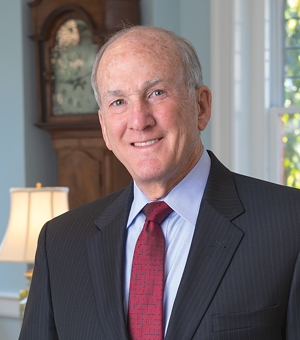Robert L. Barchi
Rutgers President, 2012 to 2020

Born in Philadelphia in 1946, Robert L. Barchi spent his formative years in Westfield, N.J. He received his B.S. and M.S. degrees from Georgetown University, and Ph.D. and M.D. degrees from the University of Pennsylvania, where he began his career in academe in 1972. At Penn, he was director of the Mahoney Institute of Neurological Sciences, founding chair of the Department of Neuroscience, and chair of the Department of Neurology. In 1999, he was named provost and chief academic officer. In 2004, Dr. Barchi would leave Penn to assume the presidency of Thomas Jefferson University, where he oversaw a period of tremendous growth, including the establishment of schools of pharmacy and population health. Throughout his career, Dr. Barchi has been active as a teacher and National Institutes of Health-funded researcher in neuroscience and neurology and has published extensively. Among numerous honors, he was elected to the National Academy of Medicine in 1993.
As he began his presidency, Dr. Barchi expressed his enthusiasm for Rutgers and for the great challenge he saw before him: “It looked like an opportunity to take something to the next level, to build. I still wanted to do something on a big scale. I don’t like to just manage things. At Rutgers, I thought I could provide value, from idea to implementation, in a way that excites me.”
Indeed, imminent developments would provide much to build on, with the university achieving three crucial milestones just months after Dr. Barchi’s tenure began: governing board approval of Rutgers’ integration with the University of Medicine and Dentistry of New Jersey (UMDNJ), voter approval of a higher education construction bond referendum, and Rutgers’ entry into the Big Ten Conference and Big Ten Academic Alliance. Asserting, “Let’s capitalize on this momentum,” Dr. Barchi announced in December 2012 his intention to develop a universitywide strategic plan that would “outline a coherent vision and a plan for moving Rutgers forward.”
“It looked like an opportunity to take something to the next level, to build. I still wanted to do something on a big scale.”
Robert L. Barchi
One year into his presidency, Dr. Barchi was deeply engaged in overseeing seismic changes, chief among them the health care merger. On July 1, 2013, Dr. Barchi welcomed UMDNJ faculty, staff, students, and alumni into the Rutgers family and the university officially began operating two medical schools; the state’s only dental school; schools of public health and health professions; the Cancer Institute of New Jersey, the state’s only National Cancer Institute-designated Comprehensive Cancer Center; dozens of research centers; and multiple clinical entities. The newly formed Rutgers Biomedical and Health Sciences would administer much of the new health care activities. Three years later, Dr. Barchi’s vision led to the establishment of Rutgers Health, uniting the university’s clinical activities under one umbrella, and two years after that he would play a pivotal role in an agreement between Rutgers and RWJBarnabas Health to jointly operate New Jersey's largest and most comprehensive academic health system.
While the Rutgers-UMDNJ integration brought Rutgers heightened visibility and new opportunities to excel, another development would offer the university the promise of reaching wider audiences and bolstering efforts to attract top students and faculty: Rutgers’ entry into the Big Ten, an athletic conference comprising research-intensive flagship state universities like Rutgers University–New Brunswick as well as fellow members of the Association of American Universities. “The Big Ten is exactly the right conference for Rutgers,” Dr. Barchi stated when the invitation to join was announced.
With its inaugural Big Ten schedule slated for the 2014–2015 season, Rutgers found competing in the powerhouse conference as hard as imagined, but in a few short years, the commitment to Big Ten athletics—including construction of new facilities for training, performance, and scholar-athlete learning—began yielding exciting results for the Scarlet Knights: Rutgers’ first national titles in wrestling, women’s soccer in the Final Four, men’s lacrosse ranked in the top 20, the Big Ten’s leading scorer in women’s basketball, and men’s basketball ranked in a weekly top 25 for the first time since 1979. Dr. Barchi’s final academic year at Rutgers saw the return of football head coach Greg Schiano, whose rehiring drew national news coverage and sparked a surge in season ticket sales and athletics fundraising.
Undoubtedly, the most visible improvements at Rutgers during Dr. Barchi’s tenure are the new and renovated buildings for academics, research, clinical care, and student life that rose on all Rutgers campuses under a $2.5 billion capital construction program, seeded by funding derived from the state’s $750 million Building Our Future bond act. Signature buildings include, in New Brunswick, Richard Weeks Hall of Engineering, Chemistry and Chemical Biology Building, Rutgers Academic Building, Honors College, and Sojourner Truth Apartments and The Yard; in Newark, the Life Sciences Center Phase II, Express Newark, Honors Living-Learning Community, and 15 Washington Street Apartments; and in Camden, the Nursing and Science Building, Writers House, Alumni House, and One Stop Services Center.
While advances continued apace at Rutgers in health care, athletics, and capital construction, the strategic planning process was well underway and would guide much of the progress to come. A Strategic Plan for the New Rutgers arrived in February 2014, the product of an intensive 18-month planning process, reflecting input from members of the entire university community. The plan was “truly a plan written for Rutgers, by Rutgers.” Emerging from the process were strategic priorities that catalyzed change and innovation in four key areas:
Building Faculty Excellence: Rutgers doubled the number of externally funded endowed chairs and created two groups of internally funded chairs resulting in an influx of world-class senior scholars and the retention of outstanding midcareer faculty. An investment of $42 million would support the recruitment, retention, and mentoring of diverse faculty. To help maintain Rutgers’ strengths in the humanities, Dr. Barchi committed to a five-year, $10 million plan to recruit and retain faculty. Research productivity and distinction among faculty reached new heights, with Rutgers University–New Brunswick ranking among the nation’s top 20 public universities in total research spending, Rutgers University–Newark gaining international recognition as a leading urban research university and anchor institution, and Rutgers University–Camden earning Carnegie reclassification as a Doctoral University: High Research Activity.
Transforming the Student Experience: Rutgers established honors colleges at Rutgers–New Brunswick and Rutgers–Newark, with the Honors Living-Learning Community in Newark carving out a new national model that relies on a holistic assessment of talents associated with a student’s ability to thrive in college. At both Rutgers–Newark and Rutgers–Camden new programs covering tuition for qualified students expanded access and opportunity. Across Rutgers, tuition increases were held at rates lower than in past years and the student body became more diverse and academically gifted. Strategically deployed technology made it easier to be a student at Rutgers with new online services for everything ranging from financial aid to campus bus tracking and scheduling. New active learning and immersive high-tech learning environments, including telepresence classrooms, further fostered student engagement.
Enhancing Our Public Prominence: To mark the 250th anniversary of Rutgers’ founding, the university carried out a yearlong celebration, with informational, scholarly, musical contemplative, and celebratory programs, including the lighting of the Empire State Building in scarlet to honor the milestone. The year’s most noteworthy highlight was hosting President Barack Obama as commencement speaker in a packed stadium on May 15, 2016, a glorious and unforgettable day for many at Rutgers. Another key event was the publication of Scarlet and Black, a faculty- and student-led project which explores the disenfranchising of African Americans and Native Americans at Rutgers and documents Rutgers’ founders’ participation in the slave trade. Rutgers shaped national policy discussions on a range of topics including campus sexual violence, immigrant rights, hate speech and free speech, and climate change. Students and faculty were the recipients of high honors and recognition, among them the Hult Prize, Marshall and Gates Cambridge scholarships, National College Fed Challenge, Fulbrights, Pulitzer Prizes, Guggenheim fellowships, MacArthur “genius grants,” the Lasker Award, the Shaw Prize, the Koch Gold Medal, and many others.
Envisioning Tomorrow’s University: Dr. Barchi oversaw substantial investments to strengthen and overhaul Rutgers’ financial and administrative systems, boost fundraising, and enhance partnerships with state and federal leaders. Rutgers completed its first $1 billion capital campaign in 2014 and achieved six record-breaking years in fundraising. Rutgers made tremendous strides in revamping its administrative systems in such areas as grant management, accounting, procurement, payroll, email, and data storage. Capital construction at Rutgers continues to provide new spaces and resources, largely emanating from a 2015 physical master plan that accompanied the university strategic plan and envisions facilities and infrastructure that will serve and strengthen Rutgers far into the future.
As he prepared to leave his presidency in 2020, Dr. Barchi was managing the greatest crisis in Rutgers’ modern era: the COVID-19 pandemic. He rose to the occasion once again, radically and expeditiously recalibrating how Rutgers educates, conducts research, and delivers services. Reflecting on his presidency, he wrote, “We can all be proud to be part of a university that is committed to a deeper and richer experience for a student body that has become more diverse and more academically gifted. Today, we share an institution deep with research excellence that can attract scholars of world renown and provide them with world-class new facilities worthy of their scholarship. And today, our institution is recognized as a national force in academic health care, born of a historic integration and now taking full advantage of a vibrant partnership with our state’s leading health care system … To be sure, there remains much more work to be done to reach our best days, and there are substantial, immediate fiscal difficulties arising from the pandemic that will need to be mitigated, but I have witnessed the resiliency of our Rutgers family, and I am certain we will have a bright and important future under President Holloway’s leadership.”

